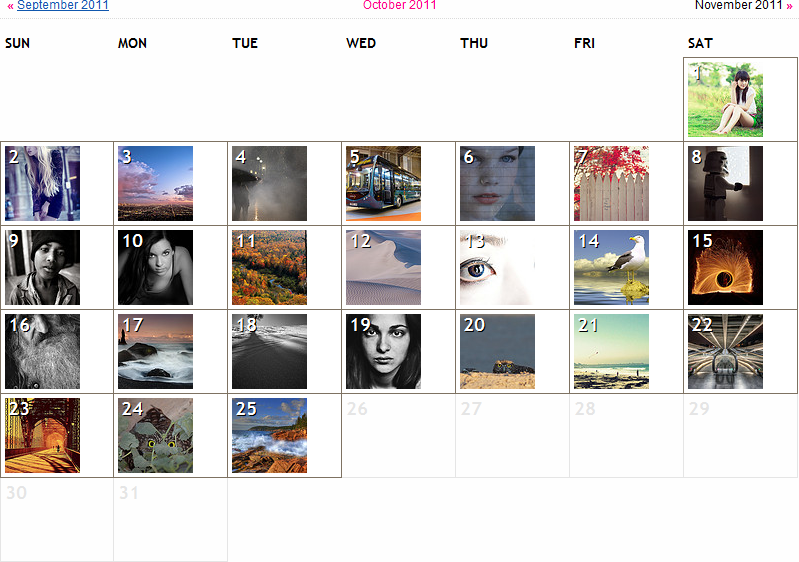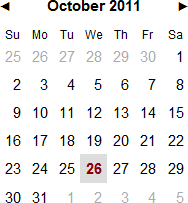UI Control of the Week: Rendering arbitrary data on a calendar with a Flickr-style CalendarMonthNavigator
This week’s UI control comes from Flickr, which for a number of years has offered a cool way to browse the most interesting user-contributed photos with their Interestingness calendar:

As cool as this is, most of the work to build this specific page was probably allocated to reproducing the same aspects of any month calendar built anywhere. That is, some Flickr developer spent a long time mucking about with date math, writing code that had nothing to do with Flickr. I’m guessing that, since the web was first created, the logic to render and navigate a calendar for an arbitrary month in HTML like this has probably been written hundreds if not thousands of times. And there are probably web sites that would benefit from displaying data in a month calendar, but can’t be bothered to make that investment.
Key attributes
- The calendar shows a complete month at a time.
- The user can navigate to the previous or next month. In Flickr’s case, navigation into the future is disabled.
- Each month shows 4 to 6 rows of seven days a week.
- Days in the previous month (on the first row, to the left of the first day of the month) and the next month (in the last row, to the right of the last day of the month) are hidden.
- Given how the photos are selected based on historical data, Flickr only shows photos for days in the past. The current date and days in the future are grayed out.
- A given date is represented visually in two ways: 1) as the number for the day of the month, and 2) as a photo thumbnail. In this case, the photo is the most interesting photo (according to the number of comments, etc.) on Flickr for that given day.
- Clicking a thumbnail pops up more thumbnails of interesting photos on that same day. The popup offers links to specific photo pages, or to a more complete list of the interesting photos for that day.
Usage
I started by creating a general-purpose CalendarMonthNavigator to handle the date and navigation logic:

Basic controls like this in the QuickUI catalog deliberately come with very generic styling. This allows one to try out the control in a minimalist mode, which hopefully makes it easy to see what the control actually does without getting distracted by its appearance. The generic styling is automatically turned off in a subclass so one doesn’t have to fight much with styles defined by the parent classes. The class used to render individual days is intended to be overridden, so that arbitrary content can be placed within a day.
A month calendar like this is well-suited for displaying date-based information using the principle of small multiples. This could be done to render historical information (sales data, etc.) as Flickr has done here, or to represent information about the future (a weather forecast, a calendar of events, etc.). If navigation is not desired — for example, if the application wants to fix which month is shown — the lower-level CalendarMonthWithHeadings can be used.
Implementation notes
Following the principle of separation of concerns, the base CalendarMonthNavigator is comprised of LateralNavigator and a CalendarMonthWithHeadings, which itself breaks down into a calendar control cornucopia: MonthName, DaysOfWeek, CalendarWeek, and finally CalendarDay.
Once the base CalendarMonthNavigator was finished, creating a custom FlickrInterestingnessDay class was quite straightforward, as was styling the month navigator. Flickr’s calendar shows the names of the next/previous month alongside the next/previous buttons, which wasn’t hard to add. By dropping the day class into the month navigator, the FlickrInterestingnessNavigator (Update: Now called FlickrInterestingNavigator.) fell out cleanly. The result is pretty close to the Flickr Interestingness calendar. One might even say it’s interestingnessish.
As far as I can tell, Flickr’s API lets you grab interesting photos only for a single date per call. Presumably they have an internal API that lets them grab the most interesting photo for each day of a given month in a single call, but no such call is documented. So this particular calendar is forced to make a separate call for each day, which is obviously terrible. Nevertheless, that performance seemed acceptable in a calendar intended mostly as a demonstration of how to create a custom CalendarMonthNavigator. In a real application, one would want to grab all the data in one call at the month level, then apportion the data to the corresponding days.
Given that performance was already an issue, I chose not to implement the popup Flickr shows when you click on a day (which shows additional interesting photos for that day). Instead, clicking a day takes you straight to the page listing the most interesting photos for a given date.
In creating the calendar controls, I was able to make use of the excellent jQuery Globalize project, which defines culture-specific information like month names and day names for a staggering number of cultures. (Thanks are due to Microsoft for contributing their vast culture database.) So the subcomponents MonthName and DaysOfWeek localize their output to the current culture if the culture has been set via Globalize.culture(). Since Globalize also indicates which day of the week should be shown as the first day of the week — i.e., in the leftmost column — I went ahead and localized that as well. For example, the first day of the week will be Sunday in the U.S., but will be Monday in France, or Saturday in Saudi Arabia. (Flickr’s own Interestingness calendar localizes the month and day names into other languages, but doesn’t correctly adjust the calendar presentation to reflect in the local culture’s first day of the week.)
Aside: I’ve added a new gallery to the main QuickUI Catalog page, showing live demos of all the controls in the catalog so far. This is only the fourth Control of the Week, but the catalog started out with a handful of controls, and most weeks see the addition of multiple related controls to the catalog, so there’s about 40 controls there now. Based on community feedback, a high priority for the next month or so will be making it possible to use the catalog controls in plain JavaScript, without needing to know anything about how QuickUI controls are created, and without having to use the QuickUI markup language (which is more concise, but entails a learning curve).